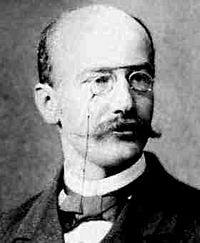Ferdinand von Lindemann facts for kids
Quick facts for kids
Ferdinand von Lindemann
|
|
|---|---|

Carl Louis Ferdinand von Lindemann
|
|
| Born | 12 April 1852 |
| Died | 6 March 1939 (aged 86) |
| Nationality | German |
| Alma mater | Friedrich-Alexander-Universität Erlangen-Nürnberg |
| Known for | Proving π to be a transcendental number Lindemann–Weierstrass theorem |
| Scientific career | |
| Fields | Mathematics |
| Institutions | University of Munich, University of Freiburg |
| Doctoral advisor | C. Felix Klein |
| Doctoral students |
|
Carl Louis Ferdinand von Lindemann was a German mathematician. He was born on April 12, 1852, and passed away on March 6, 1939. He is best known for his important discovery about the number π. In 1882, he proved that π is a transcendental number. This means π cannot be the answer to a simple algebra problem (called a polynomial equation) if the problem only uses regular numbers like fractions or whole numbers.
Life and Education
Ferdinand von Lindemann was born in Hanover, which was then the capital of the Kingdom of Hanover. His father, Ferdinand Lindemann, taught modern languages at a school called a Gymnasium. His mother, Emilie Crusius, was the daughter of the school's headmaster. Later, his family moved to Schwerin, where young Ferdinand continued his schooling.
He loved studying mathematics. He went to universities in Göttingen, Erlangen, and Munich. At Erlangen, he earned his doctorate degree. His teacher and supervisor for this degree was a famous mathematician named Felix Klein. Lindemann later became a teacher himself. He taught at universities in Würzburg and at the University of Freiburg.
It was during his time in Freiburg that Lindemann made his big discovery about π. After Freiburg, he moved to the University of Königsberg. While he was a professor in Königsberg, he helped guide the studies of several students who also became very famous mathematicians. These included David Hilbert, Hermann Minkowski, and Arnold Sommerfeld.
Proving Pi's Special Nature
In 1882, Lindemann published the work he is most famous for: proving that π is a transcendental number. This was a huge step in mathematics!
To understand what this means, think about numbers you know. Some numbers, like 2 or 1/3, are rational. Some, like the square root of 2, are irrational (they go on forever without repeating). But transcendental numbers are even more special.
- A number is transcendental if it cannot be the answer (or "root") of any polynomial equation. A polynomial equation is like an algebra puzzle, such as `x² - 2 = 0`. The answer to this one is the square root of 2.
- If the equation only uses regular numbers (like 1, 2, 1/2, -3), then a transcendental number like π can never be the solution.
Lindemann's methods were similar to those used by Charles Hermite nine years earlier. Hermite had shown that e (another important mathematical constant, the base of natural logarithms) is also transcendental. Before Lindemann's proof, people already knew that π was an irrational number. Johann Heinrich Lambert had proved that π was irrational back in the 1760s. Lindemann's work showed that π was even more complex and unique than previously thought.
See also
 In Spanish: Carl Louis Ferdinand von Lindemann para niños
In Spanish: Carl Louis Ferdinand von Lindemann para niños

